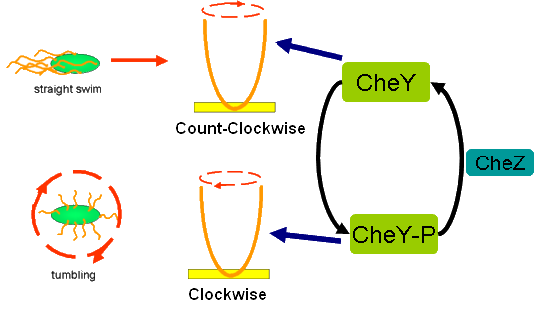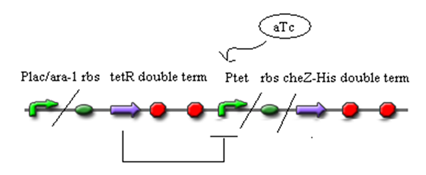Team:HKU-HKBU/Speed Control Design
From 2009.igem.org
| Line 3: | Line 3: | ||
{{Team:HKU-HKBU/header}} | {{Team:HKU-HKBU/header}} | ||
| - | = | + | =Design= |
| - | Speed control is a crutial step for our bactomotor. | + | Speed control is a crutial step for our bactomotor. As every car has an accelerator, our bactomotor should be equiped this ability to bacome a more perfect motor. |
''E. coli'' or ''Salmonella'' can swim around by the flagella rotating. When the flagella rotate counterclockwise, the bacteria form the forward motion which is called swimming. However, when the rotation is changed into clockwise, the bacteria tumble in place and are unable to swim (Fig 1). | ''E. coli'' or ''Salmonella'' can swim around by the flagella rotating. When the flagella rotate counterclockwise, the bacteria form the forward motion which is called swimming. However, when the rotation is changed into clockwise, the bacteria tumble in place and are unable to swim (Fig 1). | ||
Revision as of 12:41, 19 October 2009
Contents |
Design
Speed control is a crutial step for our bactomotor. As every car has an accelerator, our bactomotor should be equiped this ability to bacome a more perfect motor.
E. coli or Salmonella can swim around by the flagella rotating. When the flagella rotate counterclockwise, the bacteria form the forward motion which is called swimming. However, when the rotation is changed into clockwise, the bacteria tumble in place and are unable to swim (Fig 1).

To control the speed of our Bactomotor, we aim at the direct swimming of bacteria for propelling the motor and the adjustable speed of swimming within a certain range. The aim is achieved by regulation of the expression level of cheZ gene. cheZ plays the key role here is due to its influence on the expression of cheY. A high level of phosphorylation of cheY protein in E. coli or Salmonellaleads to the majority of bacteria tumbling movement, while a low level of phosphorylation of cheY protein in E. coli or Salmonella is found in non-tumbling bacteria and cheZ can function to reduce the level of phophorylated cheY in the bacteria. Therefore, when increasing the expression level of CheZ gene, we can reduce the tumbling movement, which in turn can increase the swimming speed of the bacteria to achieve the manipulation of speed.
Step 1--CheZ knockout
By using lamda red system, recombineering could be applied to knock out the CheZ gene in the chromosome of E. coli or Salmonella. Homologous arma (about 50bp) were designed inside the CheZ gene and after recombination, the CheZ was replaced and destroyed by chloramphenicol resistance gene .
Step 2--Controllable cheZ expression
An inducible CheZ plasmid is tranformed into CheZ knockout strains. Therefore, by controlling cheZ expression level, we can implement the adjustable control over the speed of the bacteria and hence the motor.
There are two designs for cheZ plasmid.
Original Design
The orinigal design is to use lacI as a repressor to prevent any leaky expression in the absence of the inducer (IPTG or arabinose). When the bacteria were treated with IPTG or arabinose(switch on), the cheZ expression level could be regulated according to its concentration and hence the swimming speed of the bacteria.
Back up Design
The back up design is to use tetR as a repressor and ptet as the regulator, which can be induced by aTc. We suppose that by changing the concentration of aTc, the expression amount of protein cheZ will be altered, which results in the speed up and slow down of the swimmng.
 "
"


